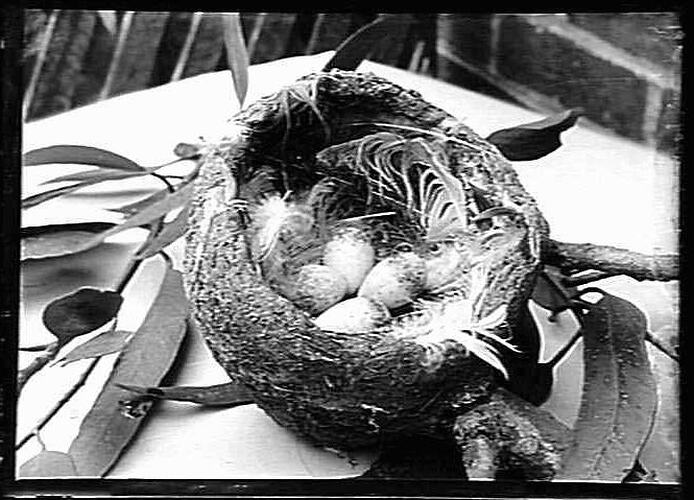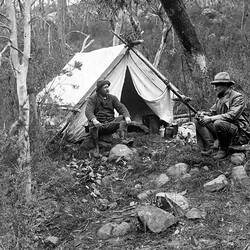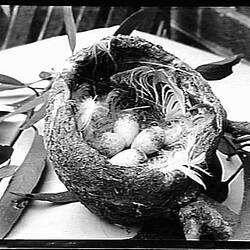MAGPIE LARK (Grallina picata, Latham - 102)
Geographical Distribution - Throughout Australia and Tasmania (accidental).
Nest - Bowl-shaped, built usually black, but varies in shade according to locality where; gathered; lined inside sparingly with grass and a few feathers, and usually situated on a bare horizontal limb of a tree in the vicinity of water, overhanging a stream, or standing in a lagoon. Dimensions over all, 5 -1/2 by 4-1/2 to 5 inches in depth; egg cavity, 4-1/2 inches across by 2-1/2 inches deep. (See illustration.)
Eggs - Clutch three to four, occasionally five; usual shape pyriform; texture of shell fine, and surface glossy; colour, pearly-white, spotted about the apex with dark purplish-red and light-purple, but generally the ground-colour is pinkish, ranging in tone from light pink or pinkish-white to rich buffy-red, with markings of pinkish-red and purple, confluent, and forming a belt around the upper quarter; in some examples the markings are more blotched, and distributed over the whole surface. Dimensions in inches of two proper clutches: (A) (1) 1.14 x .8, (2) 1.11 x .82, (3) 1.10 x .8, (4) 1.1 x .81, B (1) 1.8 x .82, (2) 1.08 x .8, (3) 1.6 x .81, (4) 1.05 x .78, (5) 1.03 x .78. (Plate 6.)
Observations - It is well that this interesting and most useful of insectivorous birds is a cosmopolitan as far as Australia is concerned. The sexes are similar in size, both black and white, but the female is readily distinguished by her white face, whereas the male's is black. Bill and eyes are yellowish in both; total length of a specimen about 10 inches. Almost in any locality where fresh water is found, from north to south or from east to west, the familiar pied-plumaged figures of the Grallina may be seen, or its plaintive call heard. However, the bird is only accidental to Tasmania. Gould was of opinion the Grallina was only a partial migrant to Northern Australia, or was not stationary there, departing during the rainy season, that is, the summer. It would be well if this statement were verified.
The hard mud-constructed nests of the Magpie Lark or Grallina always attract attention, so conspicuous do they appear, cemented on to a naked limb. Sometimes several are seen in the same tree, being the homes of successive seasons, for it takes many winters' rains to totally demolish a Grallina's nest. These old homes are also attractive to other birds, such as the White-rumped Wood Swallow (Artamus leucopygialis), and Little Cuckoo Shrike (Graucalus mentalis), the former invariably, the latter occasionally, constructing their own nests within the roomy and secure one of the Magpie Lark. If a clutch of eggs be removed, the Magpie Lark will lay again in the same nest; but a new nest is usually built every year, if not for every brood, of which there are two or more a season.
I recorded, 8th November, 1894, in the Proceedings of the Royal Society of Victoria, the occurrence of the egg of the Pallid Cuckoo (C.pallidus) in the nest of the Grallina. The nest was taken at Cheltenham by my young friend, Mt. John Sommers, and contained five eggs of the Grallina besides the Cuckoo's egg. For many years Mr. S.W. Jackson could depend on taking sets of pure white eggs, laid by a Magpie Lark, in the Clarence River district. I examined one of these singular sets in Mr. Jackson's collection.
During the wet season, 1889, in the neighbourhood of the Lower Murray, where nearly all the adjacent country was under water, some Magpie Larks, so Mr. George H. Morton informs me, elected to nest in certain very odd places. One built its nest on the rail of a swing gate; another upon the top of a post; whilst a third bird selected some iron hooks suspended in an outshed. Mr. C. M. Maplestone, a member of our Field Naturalists' Club, remembers another odd situation for a nest, where the bird reared her young securely - the top of a telegraph pole on the high road between Camperdown and Lismore, Victoria.
A friend of mine once observed a reddish-brown tree snake (Dipsas fusca) in the act of taking young from the nest of a Magpie Lark, having had his attention directed to the spot by the terrified cries of the parent birds. When the snake found it was discovered, by the presence of stout sticks whizzing past uncomfortably close to its head, the reptile flattened itself along the limb, as if to avoid observation, or at all events to evade the flying sticks.
The breeding months are chiefly from September to January. Sometimes in Queensland as early as the beginning of August; whilst in the North-west, in March (1897), the natives brought several ones into the camp of the Calvert Expedition near Fitzroy River.
The Magpie Lark is indeed one of the most useful of Australian birds. Dr. N.A. Cobb, the Pathologist of the Department of Agriculture of New South Wales, proved that this bird destroys numbers of species of land molluscs that are intermediate hosts of fluke.
References
Transcribed from Archibald James Campbell. Nests and Eggs of Australian Birds, including the Geographical Distribution of the Species and Popular Observations Thereon, Pawson & Brailsford, Sheffield, England, 1900, pp. 87-88.
More Information
-
Keywords
-
Authors
-
Contributors
-
Article types


